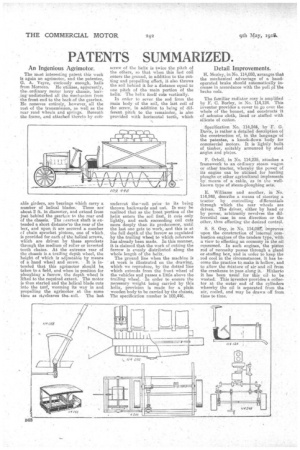PATENTS SUMMARIZED.
Page 22

If you've noticed an error in this article please click here to report it so we can fix it.
An Ingenious Agrimotor.
The must interesting patent this week Is again an agrirnotor, and the patentee, Cr. A. Veyre, curiously enough, hails from Morocco. He utilizes apparently, the. ordinary motor lorry Chassis, baying. . undisturbed all the mechanism from the front end to the back of the gearbox. He removes entirely, however, all the rest of the transmission, as well as the rear road wheels and springs. Beneath the frame, and attached thereto by suit able girders, are bearings which carry a number of helical blades. These are about 2 ft. in diameter, and extend from just behind the gearbox to the rear end of the chassis. The peartiox shaft is extended A short dietanee-to the rear of the box, and upon it are secured a number c.f chain sprocket pinions, one of which. is provided for each of the helical screws, which are driven by these sprockets through the medium of roller or inverted tooth chains. At the extreme rear of the chassis is a trailing depth wheel, the height of which is adjustable by means of a hand wheel and screw. • It is intended that this agrimotor should be taken to a field, and when in position for ploughing a furrow, the depth wheel is lifted to the required extent. The motor is then started and the helical blade cuts into the turf, worming its way in and propelling the agrimotor at the same
time as itecicavea the soil. The last screw of the helix is twice the pitch of the others, so that when this last coil enters the ground, in addition to the eutting and propelling effect., it also throws the sail behind it for a distance equal to one pitch of the main portion of the helix. The helix itself cuts vertically.
In order to sever the sod from the main body of the sail, the Last coil of the screw, in addition to being of different pitch to the remainder, is also provided with horizontal teeth, which undercut ther'eoil prior to its being thrown baCkwards and out. It may be realized that as the front portion of the helix enters the soil first, it cute only lightly, and each succeeding coil cuts more deeply than its predecessor, until the last one gets to work, and this is at the full depth of the furrow as regulated' by the trailing wheel to which reference has already been made. In this manner, it is claimed that the work of cutting the furrow is evenly distributed along the whole length of the helix.
The ground line when the machine is at work is illustrated on the drawing, which we reproduce, by the dotted 'line which extends from the front wheel of the vehicles and passes a little above the trailing wheel. • In order to ensure the necessary weight being carried by this helix, provision is made for a plain wooden body to be carried by the chassis, The specification number is 109,446,
Detail Improvements. .
H. Mozley, in No. 114,088, arranges that the mechanical advantage of a handoperated brake should automatically increase in accordance with the pull pi the brake rods.
The familiar radiator cosy is amplified by F. C. Burley, in No. 114,124. This inventor provides a cover to go over the whole of the bonnet, and constructs it of asbestos cloth, lined or stuffed with silicate of cotton.
Specification No. 114,245, by F. Cr. Davis, is rather a detailed description of the construction of, in the language of the patentee, a knock-down• body for commercial motors. It is lightly built of timber, suitably armoured by steel angles and plates.
R Orhell, in No. 114,235, attaches a framework to an ordinary steam wagon or other tractor, whereby the power of its engine can be utilized for hauling ploeghe or other agricultural implements by means of a cable, as in the wellknown type of steam-ploughing sets.
E. Williams and another, in No. 114,248, describe a means of steering a tractor by controlling differentials through which the rear wheels are driven. The driver, either by hand or by power, arbitrarily revolves the differential ease in one direction or the other, thus effecting the desired central
S. S. Guy, in No. 114,092; improve upon the construction of internal combustion engines of the tandem type, with a view to effecting an economy in the oil c.qnsurna. In such engines, the piston rod of necessity passes through a gland or stuffing box, and in order to keep the rod cool in the circumstances, it has become the practice to make it hollow' and to allow the naixture of air and oil from the crankcase to pass along it. Hitherto it has been usual for this oil to ' be wasted. This inventor provides a collector at the outer end of the cylinders whereby the oil is separated from the air, cooled, and may be drawn off from. time to time,






















